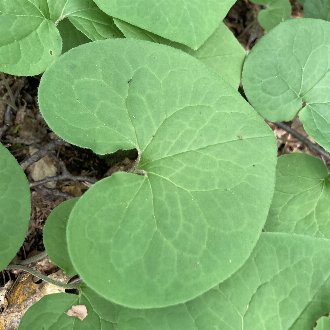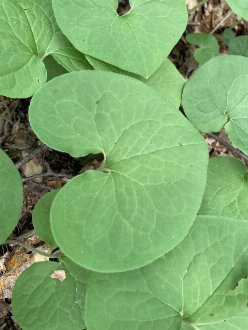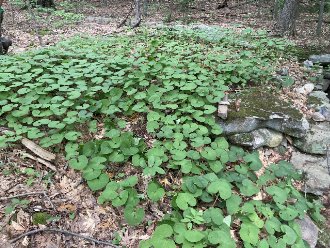Canada Wild Ginger (Asarum canadense L.)
Also known as canadian wildginger, canadian wild ginger, broad-leaved asarabacca.
↑Range - Expand
| Legend | Color |
| Native | |
| Native or Not Present | |
| Native or Expanded |
This tentative map is based on our own research. It may have limited data on Canada and/or Mexico, and there is some subjectivity in our assignment of plants as introduced vs. expanded. Read more in this blog post.
Although this plant occurs somewhere in each of these regions, it may only occur in a small part of some or all of them.
↑Habitat
Found in rich deciduous woodlands, including in well-drained sites in floodplain forests, and in mesic to dry-mesic upland forests. Often, but not exclusively found on sloped terrain, including in ravines.
Canada wild ginger tolerates a wide range of moisture conditions, from moist to slightly dry, but is absent from very dry sites or poorly-drained sites. It is usually found in rich, loamy soils with abundant organic matter, but also tolerates soils with substantial amounts of rocky material. It is not particular about soil pH and can be found on slightly alkaline soils formed on calcareous bedrock, to moderately acidic (down to about pH 5.0) soils formed on other rocks, but it is absent from the most strongly acidic or alkaline soils.
Growth is best under light shade from a slightly thin but closed canopy, but it is often found in more heavily-shaded, rich mesic forests where it grows more slowly. It can tolerate some direct sunlight on sufficiently moist sites, but it usually not competitive in sunnier conditions in larger gaps, clearings, or edges, where it is outcompeted by taller, faster-growing vegetation.
↑Life Cycle
This species is a long-lived perennial that reproduces primarily vegetatively, often forming large colonies. It occasionally reproduces by seed, and when it does, seeds are mostly produced by self-pollination.
This species exhibits epicotyl dormancy, meaning that the shoots do not emerge for a long time until after the root has emerged. The primary root emerges in late summer, triggered by warm temperatures, with most root growth occuring during autumn. Shoots do not emerge until the subsequent year, triggered by a period of cold dormancy in winter followed by rising temperatures. The cotyledons, leaflike structures made out of part of the original seed, emerge in spring before trees leaf out, when light is maximized. Plants then grow one or more true leaves which persist and photosynthesize throughout the first season.
Plants do not bloom until their second year or later. On favorable sites, plants will spread through branching rhizomes, forming a mat. New growth produces new leaves but does not bloom, whereas blooms form from older, established rhizomes. Plants bloom from mid-to-late spring, with flowers lasting about 3 weeks. During the bloom period, temperatures may be high enough in some years to facilitate insect activity, but in most years may be too cold. Flowers are self-fertile, and are structured so that they initially keep the pollen separate from the stigma, so that the flowers can be insect-pollinated if pollinators are present. As the flower ages, the stamens change position so that the flower will self-fertilize. Some studies have found that only a small portion of plants are cross-pollinated and outcrossing with other plants is rare. The tendency of this plant to grow in large vegetative colonies likely magnifies this effect.
The exact lifespan of this plant is unknown and has not been rigorously studied, but it lives many years. One simulation based on extrapolation from observed characteristics of this plant predicted a maximum lifespan of 104 years, with an average lifespan of about 3-5 years. This average figure reflects the fact that most individuals die young, but a small number of plants in favorable conditions live a long time. Plants tend to live longer in later-successional habitats that are more stable.
A majority of plants never produce any seedlings; seedlings tend to be produced by a small portion of more successful, longer-lived plants.
↑Faunal Associations
The foliage is usually ignored by mammals due to toxins. It is sometimes however eaten by slugs and snails.
The flowers are pollinated by flies, beetles, and ants. The seeds are ant-distributed.
The foliage has been reported being eaten by the larvae of the pipevine swallowtail (Battus philenor), which primarily eats plants of the distantly-related Aristolochia genus, also belonging to the Piperales order, but these reports may be erroneous.
↑Uses
Canada wild ginger is widely used in landscaping, where it makes a good groundcover. It is easy to grow in gardens, and can be grown in a wider variety of conditions than it would occur on in the wild. It establishes readily in mulch beds, where it tends to form a dense, mat-like habit that can reduce the need for future mulch application.
↑Links & External Resources
• Asarum canadense (Canadian wildginger) | USDA PLANTS Database (About This Site)
• Asarum canadense | Go Botany (About This Site)
• Asarum canadense (Wild Ginger) | Missouri Botanical Garden Plant Finder (About This Site)
• Asarum canadense | Biota of North America Project (BONAP) (About This Site)
• Asarum canadense | NatureServe Explorer (About This Site)
• Asarum canadense | Flora of North America (About This Site)
• Asarum canadense reflexum (Wild Ginger) | Illinois Wildflowers (About This Site)
• Asarum canadense | Missouri Plants (About This Site)
• Wild Ginger | Maryland Biodiversity Project (About This Site)
• Asarum canadense (Canadian Wild Ginger) | Minnesota Wildflowers (About This Site)
• Asarum canadense L. (Common Wild Ginger) | Digital Atlas of the Virginia Flora (About This Site)





